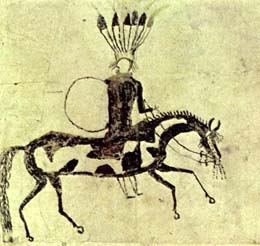Hundreds of years ago, the Native Americans who lived in Washington's Columbia Plateau region had no means of traveling on land other than walking. That all changed when local Indian groups began to acquire horses. Horses allowed tribes to travel farther and faster to gather food, hunt, and trade. Tribes placed great value on their horses. (This essay was written for students in third and fourth grade who are studying Washington State History and for all beginning readers who want to learn more about Washington. It is one of a set of essays called HistoryLink Elementary, all based on existing HistoryLink essays.)
Spanish Horses
Spanish explorers introduced horses into North America. One of those explorers -- Juan de Onate -- set out with a large army of soldiers and a group of settlers to colonize the upper Rio Grande valley in 1598. He founded Santa Fe, in present-day New Mexico, and made himself governor of the province. Spanish settlers brought livestock, including sheep, cattle, and horses. The local Pueblo Indians took care of the animals. Under Spanish law, Indians were not allowed to ride or own a horse but Pueblo stable boys learned to handle the animals. At times some were able to ride the horses on long cattle drives. On occasion, some even stole horses to run away from brutal masters and hide among neighboring tribes.
In late 1600, the Pueblos rebelled against Spanish rule. Spaniards who had settled in the area escaped, leaving their livestock behind. The Pueblos began to trade the horses that had been left behind with other tribes.
During the first half of the eighteenth century, the animals spread north through extensive trade routes and reached the Columbia Plateau. Stories passed down through oral tradition tell of how different tribes acquired their first horses.
The first time that Cayuse Indians saw a horse they were at war with the Shoshone Tribe, also known as the Snakes. Some Cayuse warriors spotted an enemy war party. It looked like they were riding on deer or elk! The warriors thought they might be seeing things so they had others come to look too. They waited until the war party had moved on and went closer to check out the tracks of the animals that had carried the enemy. They discovered that the hoofprints were not split like a deer or elk but were round and solid. This discovery upset the Cayuse chief and he decided to stop his war against the Snakes. They arranged a truce and the Cayuse received a pair of horses as a reward.
Kalispell Indians were very curious when they first saw a horse. They did not have a word for such a creature in their language so they called them "large dogs." Members of the Sanpoil Tribe remembered that even though early horses were very small, they were afraid to ride them. They thought they would fall off. So they held long sticks in each hand to steady themselves.
The Nez Perce people told stories about a gentle white mare that they had bought from the Shoshone Tribe. Day after day, the Nez Perce gathered around the horse to watch its habits and learn how to take care of it. When it had a foal, the whole tribe was thrilled. The grasslands of the Nez Perce homeland provided a great place to raise horses. Soon the Nez Perce had raised many horses and developed a strong trade network.
Owning horses changed the lifestyle of many of the landlocked Plateau tribes. It meant that they could travel farther to gather food and to hunt. It meant that they could carry heavier loads to and from their hunting or fishing camps, so they could collect a greater variety of food and haul larger amounts. It meant they could venture farther and more frequently to trade with other tribes. It meant that they could take shorter routes to their destinations. It meant that they could be better prepared and more forceful in battles. For all these reasons, the Plateau tribes placed great value on their horses. They often decorated the horse blankets, stirrups, and bridles with fancy beaded designs.

